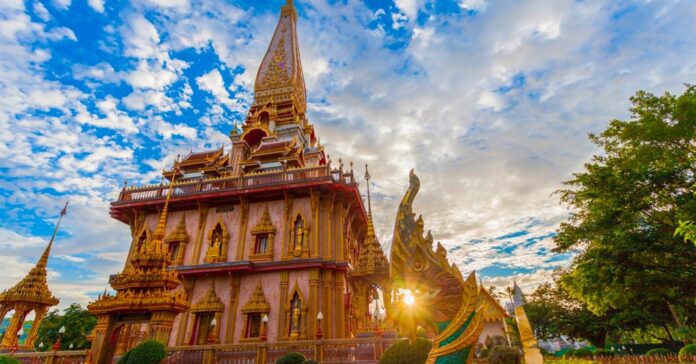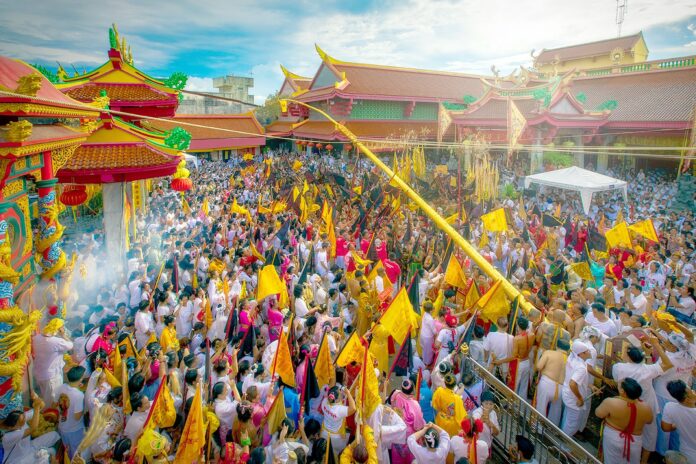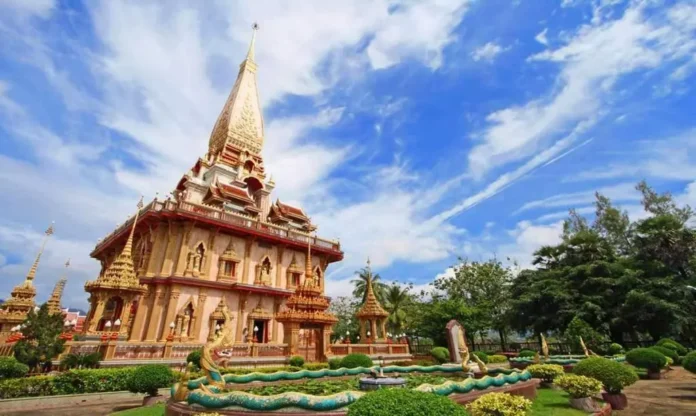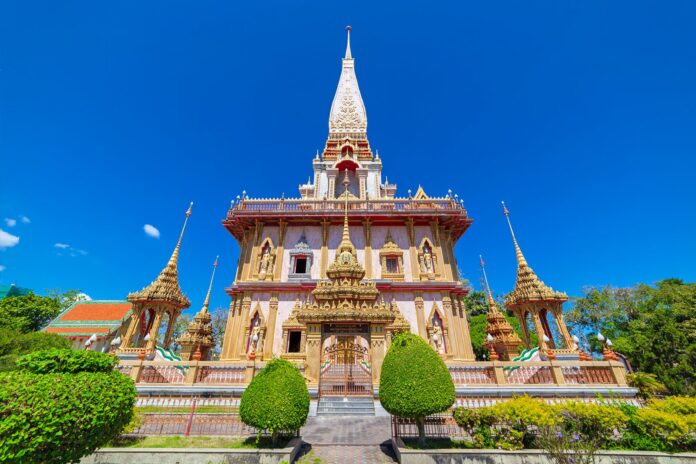Phuket, a paradise island nestled in the Andaman Sea, is renowned for its vibrant nightlife and sun-kissed beaches. Yet, beneath the island’s shimmering surface lies a rich tapestry of cultural treasures waiting to be discovered. A true gem in the crown of Thai culture, Phuket’s local temples embody the spiritual essence of this enchanting land. They provide a tangible connection to Thailand’s revered past, offering an immersive glimpse into the island’s rich heritage.
For Thais, temples or ‘Wats’ are not just religious edifices, but the spiritual lifeblood of their communities. These sacred spaces act as conduits of Buddhist teachings, preserving the island’s historical narratives and maintaining the fabric of social harmony. In Phuket, the temples stand as sanctuaries of tranquility amidst the rhythmic bustle of island life, each possessing its unique story, architectural splendor, and cultural significance. These holy sites reflect the essence of Theravada Buddhism blended with local beliefs and customs, animistic practices, and Chinese influences, making them much more than mere tourist attractions.
Wat Chalong: The Spiritual Heart of Phuket

Wat Chalong, also known as Wat Chaitararam, lies in the heart of Phuket, treasured as a beacon of spirituality and faith. As the most important of the 29 Buddhist temples scattered across the island, it has served as a place of worship and reflection for locals and visitors alike for over a century.
The temple complex houses several beautiful edifices adorned with intricate designs, but its main attraction is the Grand Pagoda. This towering structure, Poh Jao Wat, is believed to house a splinter of Lord Buddha’s bone, making it a deeply revered site. The pagoda’s walls, richly embellished with paintings, narrate the life of the Buddha, offering a captivating window into the Buddha’s journey to enlightenment.
Wat Chalong serves as a spiritual nucleus, not only facilitating religious rituals but also fostering a sense of community. It is an active hub for cultural events and local festivals such as Makha Bucha Day, Asalha Bucha Day, and Songkran, where the locals engage in merit-making, meditation, and traditional celebrations. It is an ideal palace to visit when coming back from Karon Beach Phuket.
Phuket Big Buddha: Embodying Serenity and Majesty
Majestically perched atop Nakkerd Hill, the Phuket Big Buddha dominates the island’s skyline. This 45-meter tall statue, made of white Burmese marble that glistens in the sun, is a testament to tranquillity and majesty. Visible from miles away, it is more than just a monument; it is a symbol of hope and peace for the islanders.
The statue’s grandeur extends beyond its physical manifestation. It is a spiritual powerhouse that radiates a sense of calm, attracting scores of visitors seeking a respite from worldly affairs. At the statue’s base, the serene ambiance is often punctuated by the chime of small bells and the flutter of prayer flags, adding an ethereal charm to the setting.
The panoramic view from the hilltop, encompassing Phuket Town, Chalong Bay, and the Andaman Sea, is an added draw. It is not uncommon for visitors to be found silently soaking in the breathtaking vista, their minds as expansive as the view in front of them.
Religious rituals at the site are not as elaborate as in traditional temples, yet the spiritual undertone is palpable. Offerings of lotus flowers and incense sticks are common, and it’s a common sight to see monks in saffron robes imparting blessings to visitors.
Wat Khao Rang: A Tranquil Oasis in the Heart of the City
Tucked away on the Rang Hill, in the bustling Phuket Town, lies the tranquil Wat Khao Rang, an oasis of peace that stands in stark contrast to the city’s lively vibe. Despite its relative obscurity compared to Phuket’s more famous temples, this hilltop temple provides a unique experience for those who venture off the beaten path.
Wat Khao Rang boasts a serene ambiance, lush gardens, and stunning viewpoints. At its heart sits a large, golden Buddha statue in the sitting position, radiating serenity. This statue was among the first of its kind on the island, making it a historically significant site.
The temple’s quiet, natural surroundings make it a perfect spot for meditation and reflection. The panoramic view of Phuket Town, along with the cooling breeze from the Andaman Sea, provides a peaceful setting for introspection. As one of Phuket’s oldest temples, Wat Khao Rang offers a deep connection to the island’s past, giving visitors an authentic experience of the local culture and Buddhist practices.
Jui Tui Shrine: A Colorful Blend of Taoism and Chinese Heritage

The Jui Tui Shrine, a bright, colorful temple tucked away in Phuket’s Old Town, is a testament to Phuket’s vibrant Chinese heritage. Originally built by a local Chinese miner over a century ago, it has since evolved into a major spiritual landmark for Phuket’s Chinese-Thai community.
The temple’s architecture, with its vivid colors, intricate decorations, and ornate dragon motifs, exudes an unmistakable Chinese aesthetic. The shrine’s vibrant energy is especially palpable during the annual Phuket Vegetarian Festival. During this time, devotees, clad in white, engage in various rituals such as spirit mediumship and body piercing to honor the Chinese gods.
Regardless of the time of year, visitors to Jui Tui can participate in temple rituals, such as lighting incense, making paper offerings, or shaking fortune sticks to seek guidance from the divine. These customs offer a fascinating glimpse into Taoist beliefs and Chinese traditions, making a visit to Jui Tui Shrine a cultural experience like no other in Phuket.
Wat Phra Thong: The Mysterious Half-Buried Buddha
Wat Phra Thong, or the Temple of the Golden Buddha, beckons with a unique allure. Nestled in Thalang, in the northern part of Phuket, this temple is home to a half-buried golden Buddha statue that is shrouded in mystery. According to local folklore, attempts to excavate the statue have been met with disaster, leading locals to believe that the image wishes to remain in place.
The main hall of the temple houses the golden Buddha, whose upper half protrudes above the ground. Encased in a glass casing, the image’s serene expression stands in stark contrast to the intriguing legends surrounding it.
Besides the main attraction, the temple complex also features a museum that showcases a collection of historical items, offering a glimpse into local life in the past. The lush grounds of Wat Phra Thong and its distinctive history make it a fascinating stop for culturally curious visitors.

Exploring Beyond Temples: Immersing in Local Culture
Though temples offer a rich glimpse into Phuket’s cultural heritage, there are other ways to immerse yourself in local culture. Attending traditional performances, like Thai dance and Muay Thai boxing shows, or visiting local markets for handmade crafts and regional delicacies can enrich your experience.
Partaking in a Thai cooking class or getting a traditional Thai massage can provide hands-on experiences of Thai culture. Exploring the Sino-Portuguese architecture in Phuket Old Town or visiting the island’s various museums can also provide a deeper understanding of the island’s history and lifestyle.




